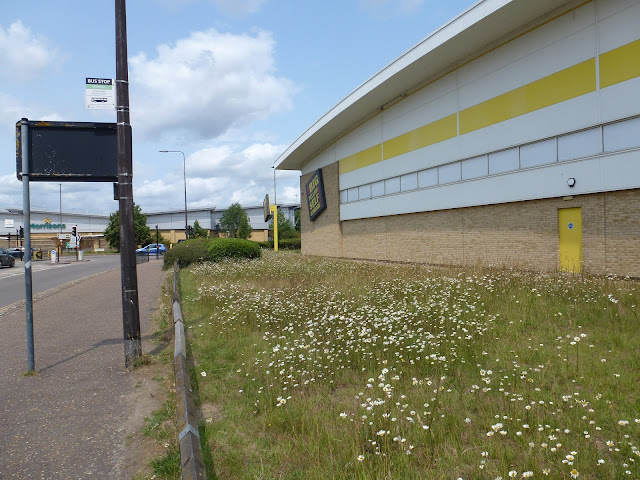Chris
Durdin joined long-time Honeyguiders Sue & Peter Burge and Helen & Malcolm
Crowder for two days out in north Norfolk. They were staying at The Pheasant
Hotel in Kelling.
17
August – Blakeney Harbour and Holt Country Park
Where
was the late August heatwave that was once forecast? On a wet morning, with a
boat trip booked for noon, we started by driving to the beach at Salthouse,
then a brief stop to overlook Cley Marshes from NWT’s visitor centre. Here, from
a fairly sheltered spot, a volunteer guide had his telescope on a pink-footed goose,
a very early arrival for the winter. There was also a good number of
black-tailed godwits, an avocet and a marsh harrier.
 |
| Mostly harbour seals; the blotchy one is a grey seal. |
After
a short detour to see Blakeney Quay we arrived at Morston in good time for the Blakeney
Harbour seal trip. A surprise was seeing spoonbills flying around,
firstly a group of four then singles in various directions. Once in the harbour
there were curlews, little egrets and oystercatchers and an interesting range
of boats described by the Beans Boats guides.
Out
on the edge of Blakeney Point there were summering eider ducks, two of them, just before
we reached the main group of seals, today mostly common (harbour) seals, mixed with
some Atlantic grey seals. Banter from the guides include seal names: Ron
(Ronseal) and a daft one called Imba seal (think about it).
We
had lunch at Holt Country Park. The rain had stopped but it was still grey, so
no butterflies on the buddleias. Once on the heath we stopped where there were bee
wolf holes and, to our surprise, one showed and did some excavating. (More about
this impressive solitary wasp here.)
 |
| Bee wolf. |
We
carried on around the edge of Holt Lowes SSSI. It was too grey for any keeled
skimmers to be on the wing though characteristic flowers included marsh
lousewort, three heather species and, in the final boggy patch, a fine show of
round-leaved sundews. |
| Round-leaved sundew, Holt Lowes (photographed on a sunnier day). |
We
then moved onto Plumstead for a tour of John Durdin’s garden.
18
August – Wells, Warham Camp and Kelling Water Meadows
We
parked near the Co-op and walked to East Quay, pausing for a lively flock of house
sparrows in shrubby sea-blite bushes. The tide was out and the saltmarsh was
colourful with sea lavender. Twice spoonbills flew past then disappeared from
view into deep creeks.
The
main lagoon at North Point pools at the eastern end had lots of water; next to it
the seasonal flood had gone, the usual routine here with winter wetlands drying
out for summer grazing. It was Helen who saw the crane in the large flock of
greylags. For such a big bird it had a knack of disappearing from view, either behind
tall rushes or in hollows.
 |
| Crane at Wells, with greylags (digiscoped). |
The lagoon had a nice selection of waders: black-tailed godwits, avocet, ruffs, redshanks,
lapwing and ringed plovers. A group of golden plovers flew around before settling
and, in its usual way, we heard the ‘choo, choo, choo’ of a greenshank before
it flew past. One of the spoonbills was in view on the way back to Wells.
 |
| Warham Camp. |
We
ate by the roadside at Warham before walking to the iron age fort. The chalk
grassland here was a sea of wild flowers: small scabious, burnet saxifrage,
stemless and carline thistles, squinancywort and thyme. We quickly saw our
first chalkhill blue butterfly and, as the afternoon warmed, scores were on the
move. Small skippers and painted ladies were among the other butterflies.
 |
Chalkhill blue butterfly, male.
 | | Female chalkhill blue (nearest), male below, on autumn gentian. |
|
Autumn
gentians were nice to find as we carried on our walk around the fort. A red-breasted
carrion beetle earns a mention; Sue found a banded demoiselle not so far from
the river at the bottom end of the circuit. Patches of yellow flowers here were
wild parsnip; on the way in they’d been ragwort, surprisingly lacking in cinnabar
moth caterpillars. A wall brown butterfly was a nice find.
 |
| Wall brown. |
 |
| Stemless thistle. |
 |
Red-breasted carrion beetle Oiceoptoma thoracicum.
|
We
returned to The Pheasant, then did the local walk to Kelling Water Meadows. A
pair of birds on a hedge top included the brightest red cock linnet I’ve seen
in a long time. The ducks on the lagoon at Kelling Quags were all gadwalls, in
moult, with a couple of black-tailed godwits. At last, some proper sunshine as
we reached and sat on the beach. The sea was calm but there were still birds on
the move: curlews, oystercatchers, common and Sandwich terns.
Chris
Durdin
































